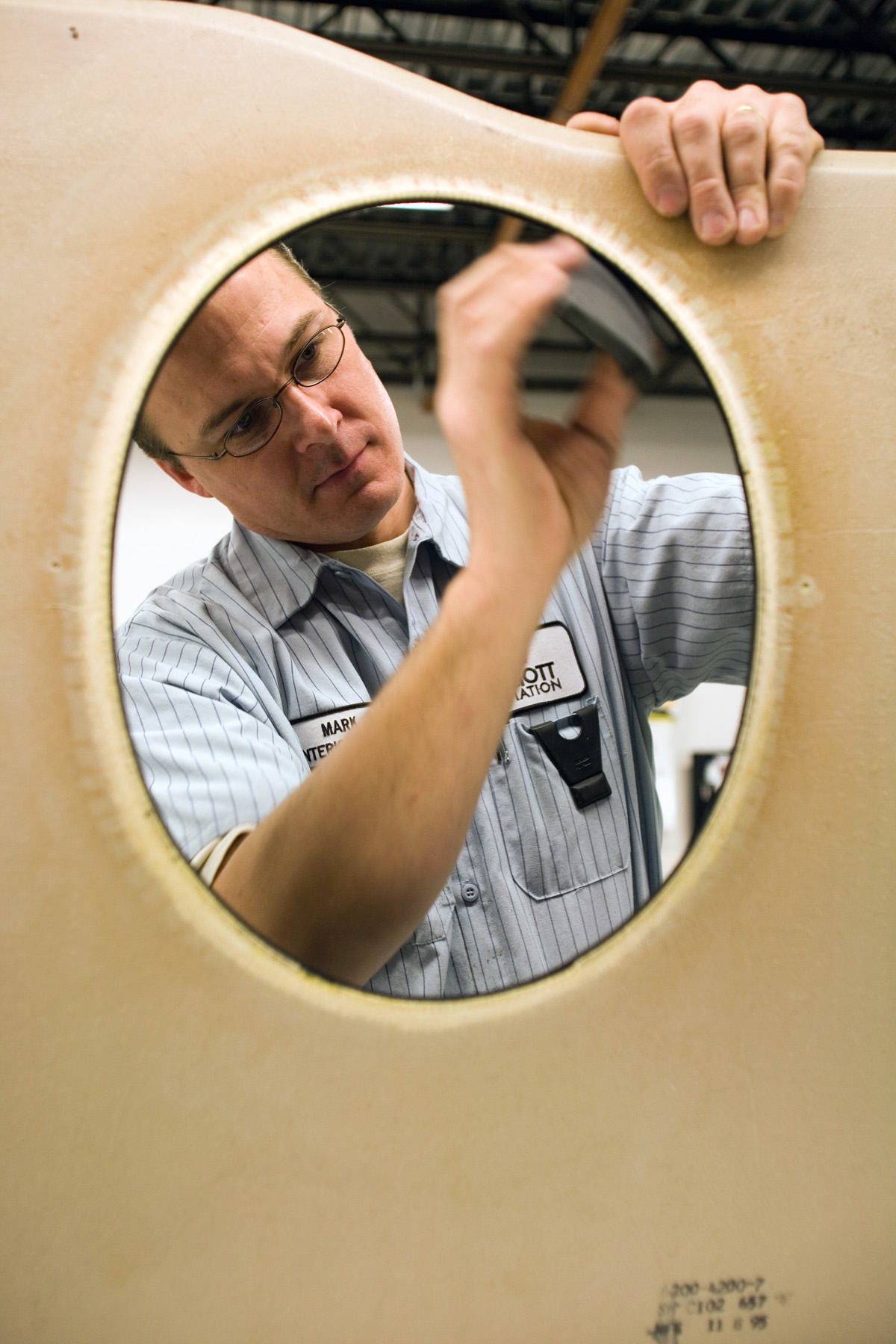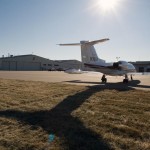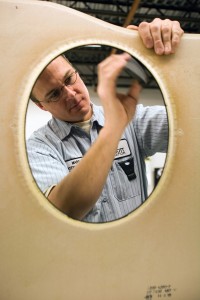
Mark Ross sands smooth the insulating layer on a Beechjet window panel before it’s covered with the interior fabric selected by the customer.
By Scott M. Spangler
Starting an aviation company in the depths of the Depression could be considered a foolhardy venture, especially when the founder was just two years out of high school.
More than anything, Herb Elliott wanted to fly. During the day, he worked as an apprentice service manager at International Harvester in Davenport, Iowa. At night, he moonlighted with a dance band. In his spare time, he spent the money he earned on flying lessons. He soloed after 2 hours and 40 minutes of instruction.
After trading $350 for an old Curtiss Junior and earning his limited commercial pilot’s license, Elliott started giving flying lessons in 1936. Later that year, he established Elliott Flying Service, at a grass strip in DeWitt, Iowa. He asked his high school sweetheart, Arlene, to manage the financial side of the business.
Sustained by an unshakeable passion for aviation, the fledgling business made its customers the focus of its services. In return, customers bought 13 airplanes that year.
The couple married in 1939 and continued to build the business until the start of World War II, when Elliott became a civilian flight instructor for the military. Later, he served as a pilot for the Fifth Ferry Command at Love Field in Dallas.
After the war, the Elliotts, with their new daughter, Pam, returned to Davenport and resumed business at Cram Field, another grass strip. They built an office, reception area and pilot lounge. Their business sold Beech and Piper aircraft and was the first independent contractor in the Quad Cities to offer charter services in multiengine aircraft.
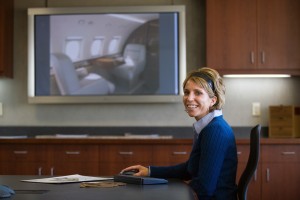
Elliott Aviation designer Meghan Welch works with customers to design new cabin interiors. The computer can depict the outcome, so customers easily see how the fabrics, colors and textures will work together.
In 1947, they decided to focus exclusively on the sales of Beech aircraft. Two years later, the business moved to the new Davenport Municipal Airport and added maintenance to its list of services. This successful operation led to the next branch, at Iowa’s Des Moines International Airport (DSM), in 1958. Three years later, Elliott headquarters moved to Quad Cities International Airport (MLI) in Moline, Ill. Building on this base, the third facility opened at Flying Cloud Airport (FCM) in Minneapolis in 1972, and the fourth at Eppley Airfield (OMA), in Omaha, Neb., in 1982.
As they had when they resumed business after the war, the Elliotts added on to the Moline headquarters to house the growing business. That process continued when their son Wynn took the helm in 1993.
Now known as Elliott Aviation, the growing company overhauled its entire Moline facility in 1998. Herb Elliott saw the dedication of the company’s 48,000-square-foot completion center in 2003. He passed away in 2005, at age 90.
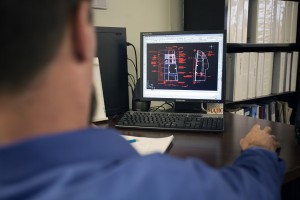
Lead mechanical engineer Tom Zick uses CAD-CAM to design a refreshment center, which will replace a baggage cabinet in a Premier I.
After nearly doubling the facility’s size, the completion center caters to old and new airplanes. Elliott Aviation prepares “green aircraft,” fresh from the manufacturer, inside and out for their corporate missions. Designers and engineers create interiors specific to each customer’s needs, and the company’s cabinet and upholstery shops recreate computer designs in laminated finishes and rich leather. Painters apply the airplane’s custom scheme in a down-draft paint bay that will hold a Citation X. The bay’s computer controls maintain the perfect painting and curing environment.
Drawing on all of its departments, Elliott Aviation gives older airplanes new lives, modifying them with more powerful and efficient engines, airframe improvements such as winglets and the latest digital flat-panel avionic systems.
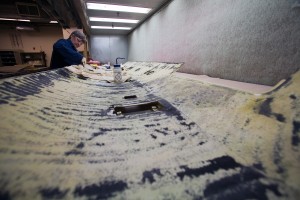
Sandy Kreiman starts the first step in the creation of this Beechjet’s new interior, which is stripping the headliner.
The work often starts with Elliott Aviation’s six full-time engineers, who design the systems and do the supplemental type certificate work if the needed improvement isn’t already in the company’s library of STCs. If a new interior is part of the upgrade, the designers use the EnVision system, which renders the engineering department’s AutoCAD efforts, to show the airplane’s owner what the finished interior will look like before work begins.
These services are only part of the total aircraft solutions Elliott provides to its customers. Add new aircraft sales, brokerage and management, charter, maintenance and other technical services such as instrument repair.
Elliott Aviation starts by building a relationship with the people it serves and focusing on their aviation needs. The company extends this philosophy to its employees, which number roughly 420, more than half based in Moline.
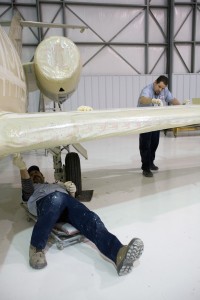
Steve Meersman applies Allquik primer filler to the wing’s top side, while Herman Velasquez works the underside.
Maintenance technician is the leading job description. All 33 techs possess an airframe and power plant certificate and are graduates of manufacturer training programs; many hold inspection authorizations. They’re divided into aircraft-specific teams, each with a lead technician who’s a key player in the total quality control effort. Working in two shifts, their mantra is to be on time, on budget and “squawk free.”
Every Elliott Aviation employee attends classes regularly. Technicians cross-train on other aircraft, and employees from every shop learn the standardized processes that make their coordinated efforts more efficient. Efficiency is key, because most airplanes draw on the contributions of more than one shop.
“Giving older aircraft new life is at the core of Elliott Aviation’s business,” says marketing representative Tom Heck, pointing to a King Air. Already wearing its new blended winglets and Raisbeck nacelle mods, it’s getting a new interior and cockpit before it goes to paint.
Always looking to the future, Elliott Aviation is now reaching internationally, earning the European Aviation Safety Agency certification for upgrades, like reverse vertical separation minimum.
“But in moving forward, Elliott Aviation is firmly anchored to the founders’ primary mission: to make its customers the focus of the services it offers,” says Sharyl Stein, marketing director.
For more information, visit [http://www.elliottaviation.com].
- Its paint cured, the line crew moves a King Air into the detail hangar for its final preparations before delivery back to the owner.
- Elliott Aviation’s headquarters facility in Moline, Ill., is housed in a four-hangar complex. The building’s office wing and corporate lounge overlooks the ramp at Quad City International Airport.











